NextGen Outdoor Camp students have the privilege of meeting with some phenomenal mentors this summer. These individuals have given of their time and resources to create impactful experiences for NextGen students that reflect GPC’s mission: to get students outside and provide them with the recreational and educational opportunities that will allow them to appreciate their home landscapes in new and exciting ways. The theme for the third week of camp was “Place-based History” and GPC sought out mentors who might be able to help the students contextualize the rich, and sometimes complicated history of Kitsap County. The following is a note from one of NextGen’s exceptional mentors from that week, Professor Floyd Aranyosi of Olympic College’s Department of Anthropology. Thursday, July 11th was a day largely orchestrated by Floyd, and he later wrote a beautiful letter of thanks to the Bainbridge Island Historical Museum docents, and Humanities Washington storyteller Clarence Moriwaki. Floyd has given us permission to share that message with GPC members.
Hello All,
I wish to offer a huge thank you to all of you. The NextGen Outdoor Camp tour was a smashing success.
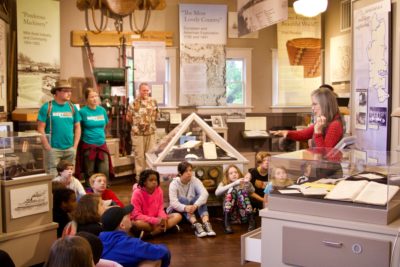
We began with a tour of the Bainbridge Island Historical Museum at 10:00 am. Museum Curator Rick Chandler kindly set up a poster display of historical and archaeological photos, maps, and newspaper stories about Yama, which he and I presented to the students. Museum docents, including a former teacher, then led students on a tour of the rest of the museum’s public collection. The students were generally “shy,” as youngsters often are, but they enjoyed the tour.
We then carpooled to the Bainbridge Island Japanese American Exclusion Memorial. There, we got to meet Mr. Clarence Moriwaki of Humanities Washington, President of the Bainbridge Island Japanese American Community organization. Mr. Moriwaki “broke the ice” by pointing to a deciduous tree in the forest of conifers surrounding the memorial. Once, long ago, someone, perhaps a person, a bird, or a squirrel, dropped a cherry pit. The tree that grew from that one cherry pit is now the tallest tree in the park.
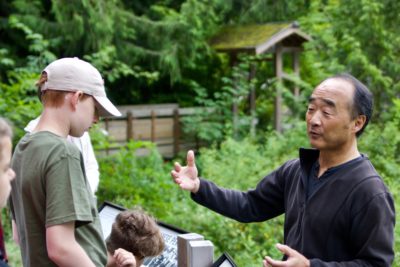
Mr. Moriwaki then led us on a tour of the memorial, and presented an emotionally powerful, moving, and informative explanation of the significance of the memorial, and its relevance to both historical and current events. Mr. Moriwaki explained that the design of the memorial is not only aesthetically beautiful, but deeply symbolic. The 276 foot distance from one end of the wall to the other is a reflection of the 276 Japanese people on Bainbridge Island who had their Fourth, Fifth, and Fourteenth Amendment rights stripped from them due to racial prejudice, wartime hysteria, and a failure of leadership at the highest levels of government due to Executive Order 9066. The weaving, meandering shape of the wall reflects and is symbolic of the unexpected twists and turns of life, but it stands atop a granite foundation. The bedrock of Western Washington geology represents the bedrock of community spirit and the camaraderie of the people of Bainbridge Island.
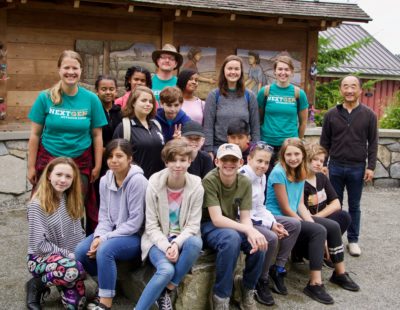
The “gap” in the memorial wall represents the time of imprisonment of the Japanese, during World War II. The gap is partly filled with a tower of non-local Columbia River Basalt cobbles, a visual reminder of the building materials used in the guard post at the entrance to the Minidoka concentration camp in Idaho, where many of the Japanese residents of Bainbridge Island spent a large part of that war. The use of rock from somewhere far from Bainbridge Island is also reminiscent of Mary Douglass’ concept of “matter out of place,” and a symbol that the Issei and Nisei people of Bainbridge Island were forcibly removed from their homes on Bainbridge Island to an unfamiliar land in Idaho. The memorial wall continues after that “gap” to represent the return home, after the war. Mr. Moriwaki’s presentation left us all with a deeper sense of responsibility and our own place in history. The students were very moved by this tour and started asking more questions and offering insights.
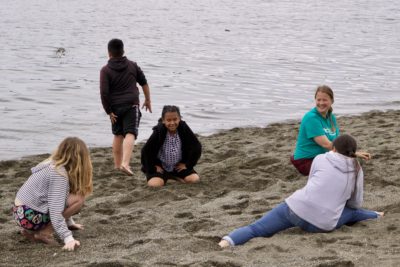
The students then enjoyed lunch in Pritchard Park, before visiting Yama. While they had lunch, Rick and I prepared the site for their visit. (Rick did all the hard work, as usual, clearing fallen trees out of the path and making sure that the entrance was accessible.)
Once the students arrived at the site, I led them on a historical tour, starting with an explanation of Captain Renton’s land grant acquisition of the area in 1863, through the booms and busts of the logging industry, the arrival of the Wataridori or “birds of passage” (Japanese bachelors) in the 1880s and the arrival of Japanese families in the 1890s. We viewed the location of the Kono family home and Washington Hotel and restaurant. We discussed archaeological field protocol, including how to establish a site grid, how to look for artifacts, and what the discoveries might tell us about people’s lives. The students enjoyed the discussion of the formation of the Japanese-American cultural identity as something that is both distinctly Japanese and intrinsically American. This group of 11 to 13 year old children intuitively understood that concepts such as nationality, ethnicity, and so-called “race” are intertwined threads of an individual’s identity, and that there is no “one right way” to be American. It was beautiful to see the students’ eyes “light up” with that recognition.
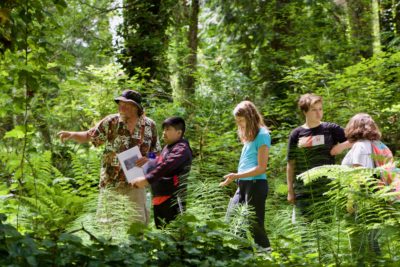
We moved north to one of the “enigmatic” U-shaped brick structures to conclude the tour. I asked the students to speculate how the features might have been used. The students offered about a dozen possibilities, and were asking lots of questions about what they had seen, and what their discoveries might mean. By the end of the tour, the students had developed so much confidence in their own positions that I probably got more questions in the last ten minutes of the tour than I had heard in the entire rest of the day!
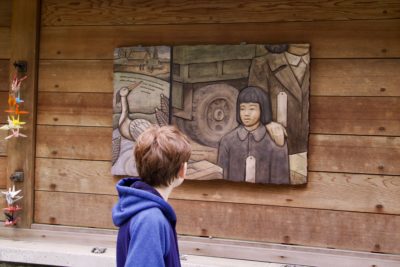
Today, 17 young people got a chance to see what archaeologists, museum curators, cultural anthropologists, historians, and other field scholars do for a living. Of course, most of the students were more interested in seeing the pieces of broken bricks and the insects and spiders on the site, rather than those vast social issues; that is understandable. We were all young children once. The small things were most fascinating to us all, when we were small. The big things come later, and they grow from the small things.
Thanks to all of you, we have planted seeds that will grow into the forests of the future, perhaps even taller than the tallest cherry tree in Washington!
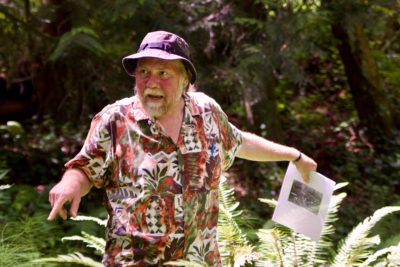
I am honored to have led this tour, and I am grateful to all of you for helping me make it happen.
E. Floyd Aranyosi
Department of Anthropology: Olympic College
Task Force Chair and Field Director: Yama Project

A follow-up note from Great Peninsula Conservancy’s Claire Voris.
To all the NextGen mentors,
I cannot say enough how privileged I feel to have community members rallying to support outdoor experiences for these deserving students. There seems to be an inherent understanding around Kitsap County that change is incremental, and, if we move forward with intention and patience, that programs like NextGen are an opportunity to make lasting, positive changes in individual lives, and within the community.
While there are many distractions for the busy minds of middle-schoolers (Floyd noted our student’s preoccupation with the secret agendas of spiders) I’ve already been witness to some of the subtle shifts in student confidence that have occurred over just the last few weeks. One student in particular has spent most of the summer trying hard not to engage with the mentors we work with. Something about Floyd’s work at Yama spurred him to tune-in in a way the teachers and I all made note of. For the duration of our hike through Yama, this student made sure to place himself at Floyd’s hip and was even brave enough to ask a question about the lives of the Japanese families who once lived there — “How did they cook their food?” It seems like such a small step, but for that particular student for whom English is not a first language, mustering the courage to speak up in front of the group was an enormous leap. I’m told that he talked about Yama for the duration of the bus route home (well, at least before he fell asleep somewhere around Silverdale, but who can blame him, he’d had a big day).
There is great diversity within our small class. Some students have ties to this land going back many thousands of years, others are the children of immigrants facing challenges today that bare striking resemblance to those faced by Japanese Americans affected by Executive Order 9066. The common element that brings NextGen Students together for the summer is that a need for outdoor education was identified, and individuals like Floyd, Clarence Moriwaki, and the docents of Bainbridge Island Historical Museum rose to the occasion to provide that opportunity. Understanding the history of our home-place is an essential part of that place-based learning, and I cannot thank them enough for helping to bring those important stories to life.
Sincerely,
Claire Voris
Events and Outreach
Great Peninsula Conservancy
